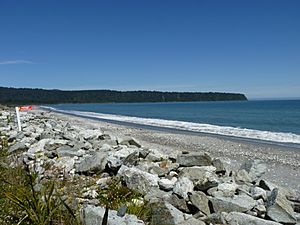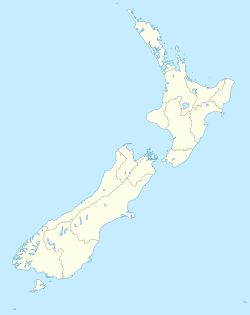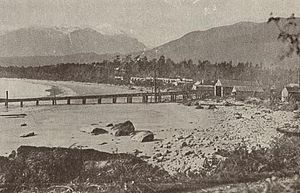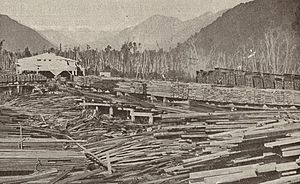Bruce Bay facts for kids
Quick facts for kids
Bruce Bay
|
|
|---|---|
|
Settlement
|
|

View across Bruce Bay to Heretaniwha
|
|
| Country | New Zealand |
| Region | West Coast |
| District | Westland District |
| Electorates | West Coast-Tasman Te Tai Tonga |
| Population | |
| • Total | 33 (Bruce Bay to Paringa) |
| Time zone | UTC+12 (NZST) |
| • Summer (DST) | UTC+13 (NZDT) |
| Postcode |
7886
|
| Area code(s) | 03 |
| Local iwi | Ngāi Tahu |
Bruce Bay is a beautiful bay and small settlement in South Westland, New Zealand. It sits right on the Tasman Sea. You can find it along State Highway 6. It's about 74 kilometers (46 miles) northwest of Haast and 45 kilometers (28 miles) southwest of Fox Glacier. The settlement of Bruce Bay is just south of where the Mahitahi River meets the sea.
This bay is a special place for wildlife. It's a nesting spot for the amazing Fiordland crested penguin. Sometimes, you might even see Hector's dolphins or southern right whales swimming near the shore! Some of the natural forest around the bay has been cleared for farms. If you walk on the beach, you can often find shiny quartz stones.
Contents
History of Bruce Bay
Bruce Bay has a rich history, from ancient Māori legends to exciting gold rushes. Let's explore some of the interesting stories from its past.
Māori Legends and Early Life
Local Māori have a fascinating oral tradition about Bruce Bay. They say this is where the famous explorer and trickster Māui first landed in New Zealand. Before he arrived, Māui had to defeat two huge taniwha (water monsters) that guarded the bay. The headland at the western end of the bay is called Heretaniwha. This name means "to tie up the monster," reminding everyone of Māui's brave act.
Archaeologists have found signs of Māori living at Bruce Bay as far back as the mid-1300s. These early settlers ate many kinds of fish, like red cod and barracoutta. They probably caught some of these fish from canoes out at sea. They also gathered shellfish such as tuatua and mussels. Bones from dolphins and seals have been found too, showing they were part of their diet. Many tools made from stone and bone have been discovered. These tools were used for fishing, preparing food, and shaping wood.
The Gold Rush Excitement
In 1866, Bruce Bay became famous for something called "Hunt's duffer gold rush." A gold prospector named Albert Hunt had found gold near Hokitika. He was given a claim about 10 kilometers (6 miles) south of the bay. About 500 gold miners from Ōkārito watched him closely. On March 26, they forced Hunt to show them where his gold claim was. He managed to escape, was caught again, and then escaped a second time. By then, more than 1,500 men had set up camp at Bruce Bay, hoping to find gold.
When the angry crowd returned to the bay, they caused a riot. Six temporary stores were destroyed and robbed. The next day, special police officers were brought in. The leaders of the riot were charged with causing damage.
The town that grew up at Bruce Bay during this time was called Weld Town. It had a changing population of over 2,000 people. But the gold rush quickly ended as many miners moved north. Even so, 300 hopeful miners stayed at Bruce Bay for a few more weeks. Later, some gold claims were set up along the coast from Ōkārito to Bruce Bay. At its peak in June 1866, over 12,000 ounces of gold were found.
Weld Town and the Timber Mill
A surveyor planned a town called Weld Town at Bruce Bay. It was named after a former leader, Frederick Weld. Even though the name appeared on maps, people rarely used it. The town itself was never properly built.
In 1934, work began on a timber mill at Bruce Bay called Bruce Bay Timbers Limited. The mill settlement was built on the same spot where Weld Town was supposed to be. The mill opened in September 1935. It stopped working after a big storm on February 28, 1945. The storm caused floods and damage, which shut down the small power plant that supplied electricity to the mill.
The Bruce Bay Timbers mill cut down trees like kahikatea, rimu, mataī, and tōtara. These trees came from Māori-owned land, and the mill paid the owners for them. The mill processed about 1,250,000 feet of timber each year.
The mill settlement had homes for the workers and their families. It also had a store, a billiard room, and a cookhouse. A special tramway carried the cut timber from the mill to a place called Flower Pot Rock. From there, the timber was loaded onto small boats called lighters using a flying fox system. These lighters then took the timber out to bigger ships waiting offshore.
The timber company also built a bridge across the Mahitahi River. This bridge helped people get to the settlement. However, heavy rain washed the bridge away in May 1942. It was damaged again in 1945 and 1946. In July 1946, the timber company stopped fixing the bridge. This was a big reason why the settlement eventually closed down.
A school opened in the mill settlement on June 8, 1936, with 14 students. It was first called Weldtown School. Later, it became Bruce Bay School. In July 1945, students from a nearby school joined the Bruce Bay School. But in late 1947, Bruce Bay School closed because the mill was gone and the bridge was unsafe.
What's in a Name?
The name "Bruce Bay" comes from a paddle steamer called PS Bruce. This ship sailed along the West Coast and carried miners during the West Coast Gold Rush.
Te Tauraka Waka a Māui Marae
Marae are important meeting places for Māori communities. Te Tauraka Waka a Māui Marae opened at Bruce Bay on January 23, 2005. Its name, "Te Tauraka Waka a Māui," means "the landing place of Māui's canoe." This name remembers the legend of Māui landing on the nearby beach.
This marae is the tribal meeting ground for the Kāti Māhaki ki Makaawhio hapū (sub-tribe) of Ngāi Tahu. It includes a wharenui (meeting house) called Kaipō and a wharekai (dining room and kitchens) called Pōkē. For 140 years, Bruce Bay didn't have its own marae, so the community used the local hall instead.
The land for the new marae was made available through a land swap with the Department of Conservation. The building of the marae was possible after the Ngāi Tahu Treaty settlement. Many artists helped create the beautiful marae, including Fayne Robinson, Puhanga Tupaea, and Bevan Climo.






